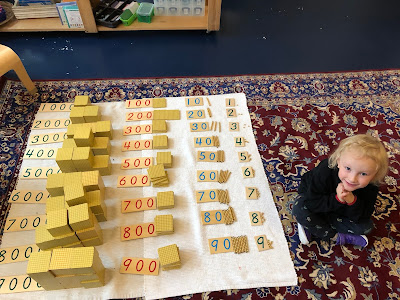Our children are lucky. They get to spend time with beautiful materials in a beautiful space. I have always been enamoured with the golden beads. In my early days when I was learning to become a Montessori teacher I spent a lot of time with the golden beads. The bead cabinet in my training classroom was all made of glass. They were shiny. The glass beads cool to the touch, and they made a beautiful sound when they clinked together. I was desperate to have glass beads in my own classroom one day and I promised myself I would. That was until I learned how impractical they are and how often they get dropped and break. I still would have committed to them except replacing glass beads is impossible. The beads would have to be taken apart and rewired. We have all the golden bead material in our classroom. It's not glass, it's plastic but it is still beautiful and the children are equally drawn to it. Getting to work with the golden beads represents growth and new responsibility in the classroom. It is regarded as 'big' work.
 |
| Collecting hundreds from the bead cabinet |
| As an extension of this work, after I have already given the initial presentation. I like to have the child go to the bead cabinet and math shelf to build their own set. I find the concept really lands with the child when they can count and see ten units makes a ten and ten tens makes a hundred and ten hundreds makes a thousand. In this photo, that is what my friend Edward is doing. The purpose of this exercise is help the child understand the decimal system by showing that after nine a new category or power of ten is created. Another exercise that happens during this period is the teaching of the written symbol for the powers of ten. We have beautiful wooden number cards one, ten, one hundred and one thousand. The numerals from one to nine are in green (ones), ten to ninety in blue (tens), one hundred to nine hundred in red (hundreds), one thousand to nine thousand in green (thousands). The child will then practice laying the number cards out in the correct order from left to right and when confident they will then be invited to add the quantity to the number as shown in the picture below. This is such an "aha" moment for the child to see the written number and quantity together. We call this work the 'Bird's Eye View' |
 |
| Adding golden beads (quantity) with number |
 |
| Bird's Eye View |
My friend Edward, is immensely proud of his work as he should be. This work took the better part of the morning to do and his commitment and focus was unwavering.
*Please note ~ Permission was granted to post pictures of my friend Edward for this post. It is our policy to always protect children around social media and if I post pictures of our classroom I will never post anyone's face without permission from parents.


No comments:
Post a Comment